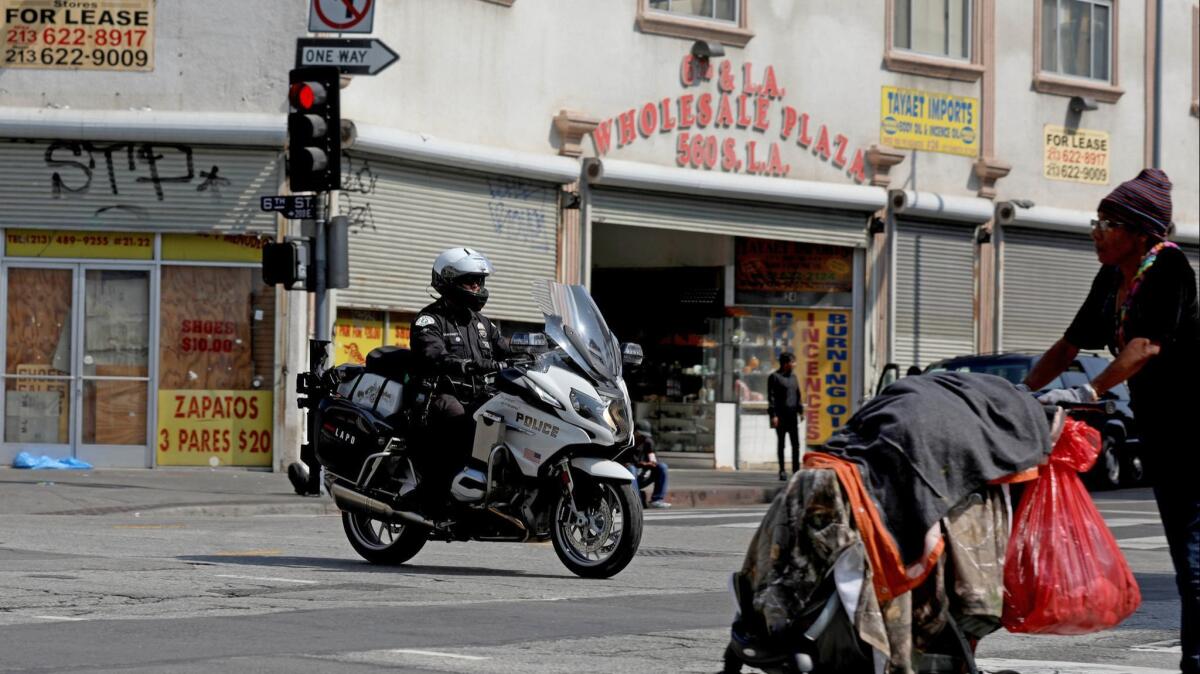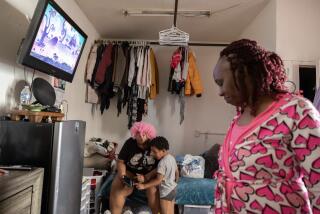Rats and other vermin infest LAPD downtown station, sparking anger among officers

- Share via
When state officials inspected the Los Angeles Police Department’s Central Division station last November, they uncovered rodent infestations and other unsanitary conditions at the facilities responsible for protecting skid row and other parts of downtown.
The conditions have now become the source of growing anger inside the station, with some officers threatening to seek transfers and city leaders scrambling to address the problems.
The issues at the Central Division come amid larger concerns about disease and filth across downtown, notably a vermin infestation at City Hall last year. One city employee was diagnosed with typhus, a disease that can be spread by rodents. City Hall workers said they saw fleas, rodent droppings and plants eaten by vermin in the building.
The California Department of Industrial Relations issued six violations and a $5,425 fine to the LAPD on May 14 and two violations and a $1,910 fine to the Department of General Services, records reviewed by The Times on Thursday show.
On Thursday, Mayor Eric Garcetti and the LAPD said they are working to resolve the problems. The division has 414 sworn officers — the largest number in the city.
“Our officers work hard every day to protect our city, and they deserve the best working conditions,” said Alex Comisar, a Garcetti spokesman. “Whether the issue is bad plumbing or something else, the mayor is working with the department to get to the bottom of this situation — and will take every possible step to protect the health and safety of all our employees.”
The department added: “The state’s report is concerning and we are taking steps to ensure the men and women who work for the Los Angeles Police Department can come to work in a healthy environment.”
The LAPD announced late Wednesday that an employee who fell ill at the downtown LAPD station had contracted the strain of bacteria that causes typhoid fever and was being treated for the condition. The LAPD confirmed that a second employee had a lower intestinal infection, but a specific diagnosis has not been determined.
It’s unclear where the officers contracted typhoid, though officials said they were not patrol officers. The LAPD appeared to link the case to officers’ work conditions, saying in a statement that “our police officers often patrol in adverse environments and can be exposed to various dangerous elements.”
Yet several experts said it was highly unlikely the the officer contracted typhoid on the job or even in the country, where the spread of typhoid is rare. The filthy conditions that the LAPD was cited for aren’t related to the spread of typhoid, experts say.
“It would be very important to know what the travel history is for the past six to eight weeks,” Dr. Robert Winters, an infectious disease doctor who runs a travel clinic in Santa Monica, said of the sick LAPD officer. “It’s not something you worry about going to Starbucks or McDonald’s.”
Two police sources said officers are considering taking a hard stance and filing paperwork to transfer from the station. One concern, the sources said, was that some officers reported getting sick from chemicals used to kill fleas, said the sources, who spoke on the condition of anonymity because they were not authorized to comment publicly.
Among the violations at the station on East 6th Street, according to the state, was that the LAPD did not train employees about how the dangerous bacterial disease typhus is transmitted, its symptoms or measures for prevention. The department also did not have a program to exterminate and control rats, fleas, roaches, gnats, mosquitoes or grasshoppers in the building. Inspectors found all those in the facility, records show.
Other state violations came from failing to clean “dust, dirt/suspect mold/fungus from the HVAC registers within a reasonable time”; for using extension cords instead of fixing wiring in the detectives area; and for not keeping the parking garages, stairwells and records room clean, according to the citations.
The state fined the Department of General Services for not maintaining the building. The department submitted an appeal to the state Tuesday. A statement from the department said it has addressed some issues and routinely conducts pest control activities and provides daily cleaning services.
The board of directors for the Los Angeles Police Protective League, the police labor union, said “officers worry enough about being shot or injured policing the streets of Los Angeles” and shouldn’t fear taking home infectious diseases.
Robert Harris, a union director, called the conditions “pretty disgusting” in the Central Division headquarters and called on the city to hire outside experts to craft a plan to sanitize all police facilities.
“We’re trying to be a proactive partner to clean up these toxic work sites,” Harris said. “Let’s clean it up before we have a massive outbreak.”
Still, it is even more challenging for the city to keep downtown disease free with the thousands of homeless living on the streets. The areas with large homeless populations have major effects on public health, said Dr. Neha Nanda, epidemiologist at Keck School of Medicine at USC.
Typhus, in particular, is spread by fleas that live on rats and then bite humans, something that could become more common as more people live on the streets.
Thirteen people in the state were diagnosed with typhus in 2008, compared with 167 last year. More than 95% of the people falling sick in California are in Los Angeles and Orange counties, according to state health data.
In October, L.A. County officials declared an outbreak of typhus linked to overcrowding in downtown L.A. around skid row. A major outbreak of Hepatitis A in San Diego linked to homelessness killed 20 people two years ago.
Nanda said that growing homeless populations often create unsanitary conditions that contribute to the spread of disease, even some “that are coming back from the historic times.”
Typhoid too is linked to unsanitary conditions, as it is transmitted through water and food contaminated with fecal matter, Nanda said.
So far this year, the L.A. County Department of Public Health has received reports of five cases of typhoid, according to officials. Last year, there were 14 cases of typhoid fever in the county, they said. Most cases occur in people who traveled to countries where the disease is common, they said.
“It’s not seen that often, but if we follow that theory — that homelessness is increasing — and we see the surges of Hepatitis A and typhus and all these things, why not typhoid?” Nanda said. “How much can our infrastructure take?”
More to Read
Sign up for Essential California
The most important California stories and recommendations in your inbox every morning.
You may occasionally receive promotional content from the Los Angeles Times.














